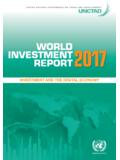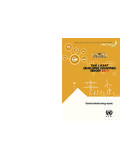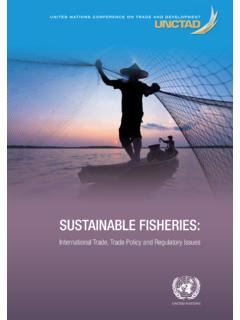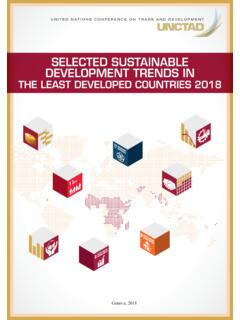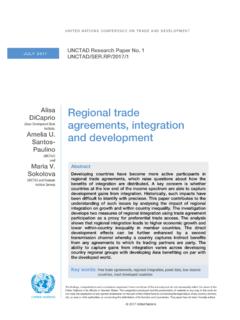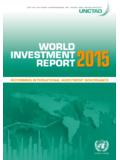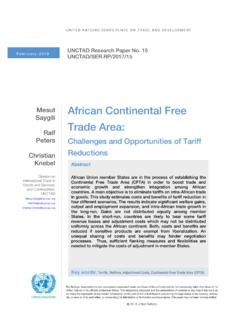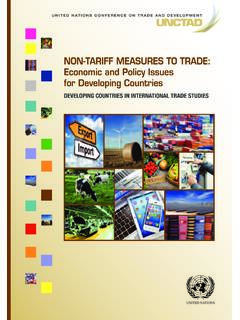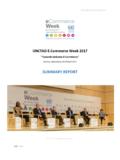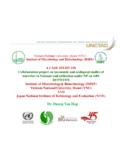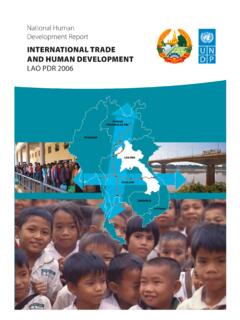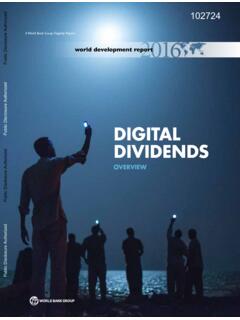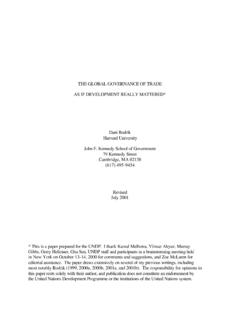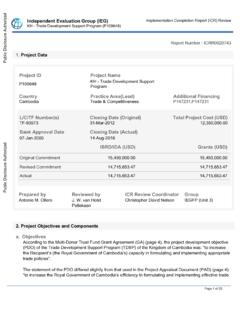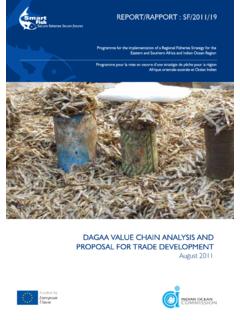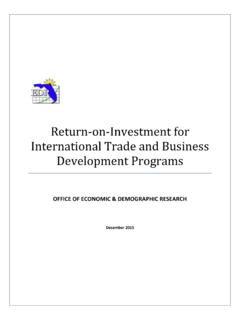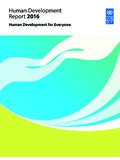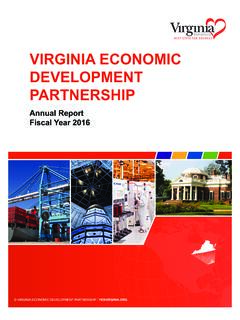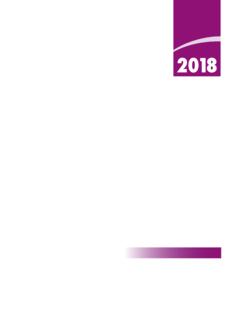Transcription of TRADE AND DEVELOPMENT REPORT, 2015 - UNCTAD | Home
1 Making the international for developmentTRADE AND DEVELOPMENT report , 2015 UNITED NATIONS CONFERENCE ON TRADE AND DEVELOPMENT financial architecture workUNITED NATIONS CONFERENCE ON TRADE AND DEVELOPMENTGENEVATRADE AND DEVELOPMENTREPORT, 2015 report by the secretariat of theUnited Nations Conference on TRADE and DevelopmentUNITED NATIONSNew York and Geneva, 2015 Symbols of United Nations documents are composed of capital letters combined with figures. Mention of such a symbol indicates a reference to a United Nations document. The designations employed and the presentation of the material in this publication do not imply the expression of any opinion whatsoever on the part of the Secretariat of the United Nations concerning the legal status of any country, territory, city or area, or of its authorities, or concerning the delimitation of its frontiers or boundaries.
2 Material in this publication may be freely quoted or reprinted, but acknowledgement is requested, together with a reference to the document number. A copy of the publication containing the quotation or reprint should be sent to the UNCTAD secretariat; e-mail: NATioNS PUbliCATioNSales No. iSbN 978-92-1-112890-1 eiSbN 978-92-1-057361-0iSSN 0255-4607 Copyright United Nations, 2015 All rights reservediiiExplanatory notes ..ixAbbreviations ..xOVERVIEW ..I XVIIIT rade and DEVELOPMENT report , 2015 ContentsPageChapter ICurrent trends and Challenges in the World eConomy ..1a. recent trends in the world economy ..1 1. Global growth ..1 2. international TRADE ..6B. recent developments in commodity markets ..10 1. evolution of main commodity prices ..10 2. The continuing influence of financial factors ..14 3. impact and prospects ..15C. stagnation: secular or temporary?
3 16notes ..18references ..19 Annex to chapter Ihave Commodity markets de-Financialized? ..21 Chapter IIFinanCialization and its maCroeConomiC disContents ..27a. introduction ..27B. the challenges of global liquidity expansion ..29 1. liquidity expansions before and after the crisis ..29 2. The rise and aggregate risks of capital inflows to DTes ..30 3. Greater financial integration and increasingly unstable capital flows ..33iv PageC. The macroeconomic costs of financialization ..35 1. effects of unfettered financial integration on prices and policy ..35 2. learning from the past: Public sector finances and economic DEVELOPMENT after financial crises ..39 3. looming losses: Fiscal stance, macro policy and aggregate demand.
4 44d. Concluding policy discussion ..46notes ..48references ..50 Chapter IIIsystemiC Challenges in the international monetary system ..55a. introduction ..55B. the international monetary system: main challenges and evolving responses ..57 1. The gold standard and the bretton Woods system ..57 2. The post-bretton Woods era ..58C. reforming the international monetary system ..63 1. Creating a new global monetary order ..63 2. Reforming the dollar standard ..67 3. Strengthening regional and interregional cooperation ..71d. Conclusions and policy agenda: merits and drawbacks of current reform proposals ..75notes ..78references ..82 Chapter IVFinanCial regulatory reForm aFter the Crisis ..87a. introduction ..87B. Post-crisis financial reform and prudential regulation ..88 1. The new basel iii Accords ..89 2. The proposed framework for systemically important banks ..90 3. The prudential framework and developing countries.
5 92 4. Some attempts to ring-fence banking operations ..94v PageC. the rise of the shadow banking system ..96 1. The emergence and principal features of the shadow banking system ..96 2. How big is shadow banking? ..97 3. Risks associated with shadow banking ..102 4. insufficient reforms ..103d. Other important issues in financial regulation ..104 1. Credit rating agencies: The need for more than a code of conduct ..104 2. The negative impacts of speculative international capital flows ..108 3. Foreign bank presence in developing countries ..109e. Fixing finance: The need for a more positive agenda ..111notes ..113references ..115 Chapter Vexternal deBt and deBt Crises: groWing VulneraBilities and neW Challenges.
6 119a. introduction ..119B. sustainability of external debt: main issues ..120C. trends in the volume and composition of external debt ..122 1. evolution of external debt in developing and transition economies ..122 2. Public and private borrowing and lending ..124 3. Currency-related issues ..129 4. The jurisdiction for debt issuance ..130d. external debt resolution ..130 1. external debt crises: A recurrent problem ..131 2. Sovereign debt issues in historical perspective ..132 3. emergence of a fragmented resolution system for external sovereign debt ..133 4. An inefficient and unbalanced approach to debt resolution ..137e. alternative mechanisms for debt restructuring ..141 1. Contractual or market-based approaches ..141 2. Need for internationally accepted principles for SDRMs ..142 3. Statutory approaches to multilateral debt restructuring ..145F. Conclusions.
7 147notes ..147references ..150vi PageChapter VIlong-term international FinanCe For DEVELOPMENT : Challenges and possiBilities ..153a. introduction ..153B. Financing through official cooperation ..154 1. official DEVELOPMENT assistance from developed countries ..155 2. DEVELOPMENT cooperation among developing countries ..157 3. Challenges of official cooperation ..158C. public-private partnerships for DEVELOPMENT ..160 1. Scale, scope and use of PPPs ..160 2. Assessing the contributions and costs of PPPs ..163 3. Policy implications ..165d. Can sovereign wealth funds make a difference? ..165e. DEVELOPMENT banks: their evolution and potential for supporting DEVELOPMENT ..166 1. Distinctive features of DEVELOPMENT banks.
8 166 2. The changing landscape of DEVELOPMENT banks ..168 3. The potential financing role of South-led multilateral banks ..170F. Conclusions ..172notes ..174references ..176viiList of chartsChart Page World TRADE by volume, January 2005 May 2015 ..7 Monthly commodity price indices by commodity group, Jan. 2002 June 2015 ..11 Money manager positions and crude oil prices, March 2014 July 2015 ..14 Commodity assets under management, April 2006 May 2015 ..22 Correlations between commodity indexes, equity indexes and the dollar exchange rate, 2000 2015 ..22 The composition of total open interest in WTi crude oil on NYMeX, by trader category, 2006 2015 ..23 Foreign capital inflows into developing and transition economies by components, 1970 2013.
9 31 Foreign reserve stocks in developing and transition economies, 1970 2013 ..32 Composition of capital flows, selected developing and transition economies, 2002 2013 ..34 Net capital inflows, nominal exchange rates and nominal interest rates in selected developing and transition economies, 2002 2013 ..37 Foreign exchange holdings of selected country groups, by currency denomination, 1995 2014 ..61 Cross-border liabilities and foreign-exchange reserves of selected developing countries, 2005 2013 ..70 Features of the current dollar standard and alternative reform proposals ..76 Assets of the five largest banks as a proportion of total assets of the banking sector in selected economies, 1998 2011 ..91 Size of shadow banking by different measures, 2001 2013 ..100 external debt, selected country groups and China, 1980 2013 ..123 external debt stock as a proportion of GNi, selected country groups and China, 1980 2013.
10 124 interest payments on external debt as a proportion of exports, selected country groups and China, 1980 2013 ..124 external debt by type of debtor, selected country groups and China, 1980 2013 ..125 long-term external debt by type of creditor, selected country groups and China, 1970 2013 ..127 long-term external debt owed to private creditors, by type of debt, selected country groups and China, 1970 2013 ..128 oDA provided by DAC countries, 1990 2014 ..155 Composition of developmental oDA by main categories, 1990 2013 ..156 Private sector participation in infrastructure, 1985 2013 ..161 infrastructure sector financing in the european Union, by category, 2009 2011 ..162 Total assets and loans, selected national DEVELOPMENT banks, 2014 ..169viiiList of tables and boxesTable PageBox Page The euro zone crisis, a case of d j vu.
